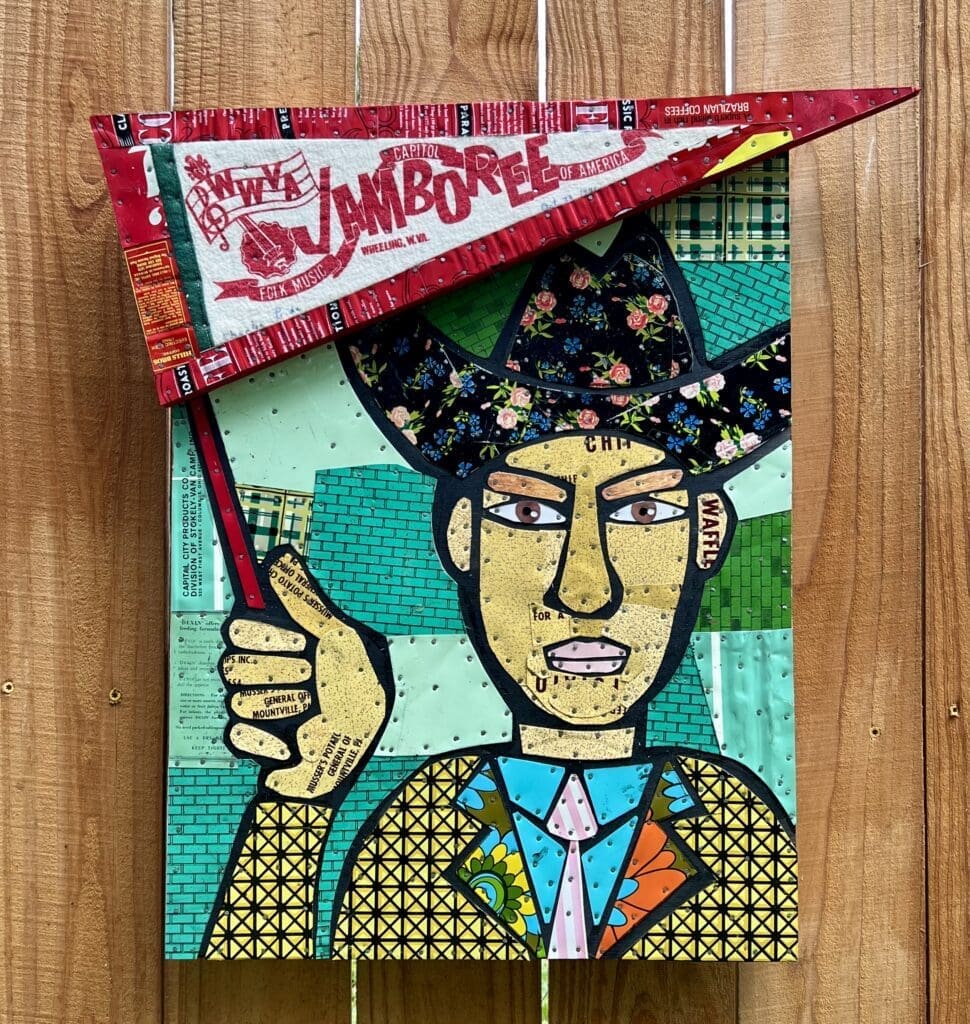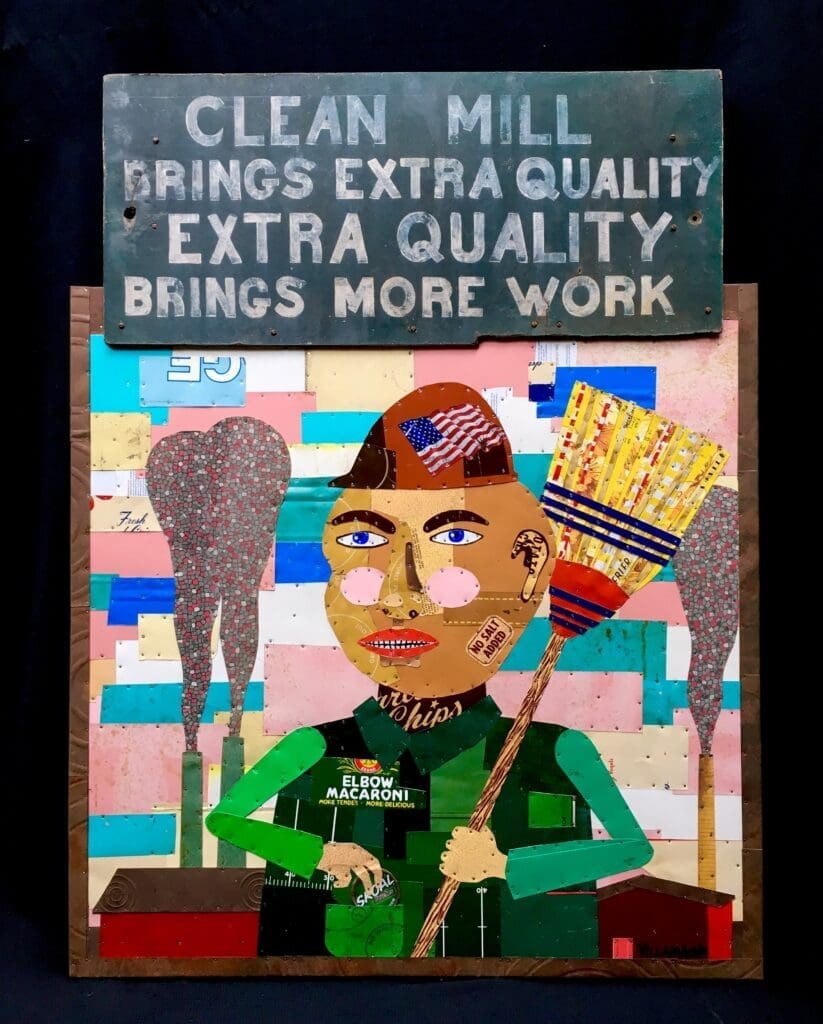
It’s the way he sees it.
And when you say something like that about Robert Villamagna, you mean there’s more than what meets his eyes when he interprets what goes into his works of art. And no one sees it the same because, when it comes to this artist’s imagery, it all makes sense in a different way never considered before.
Take his “Old King Coal” piece as an example. Once upon a time ago, coal was king in West Virginia, and for decades fossil fuels ruled in Kentucky, too. In Appalachia America not so long ago, if a kid quit high school to work in the mines, he was simply following in his daddy’s footsteps into coal country. Not only was it acceptable, it was expected, but it’s different these days and that’s why Villamagna’s coal king is crying.

He honors people with his art, and his work speaks to social and commercial issues, too, and from his first step to his final step, the process proves a mission of imagination on every occasion. Sometimes Villamagna “sees” it first and then builds it, and sometimes this tin man’s heart is inspired – literally – by discarded junk.
No matter what prompts his projects, Villamagna’s mixed media style is fantastically distinctive, and his work is in high demand, too. After more than 20 years as an associate professor of art at West Liberty University, he’s now a full-time artist – with office hours, to boot – and these days his work often is described quite simply as “It’s a Villamagna.”
And ain’t that just cool?
Combining the lithograph metals, vintage photos, and, as you describe, “found objects” … how – and why – did all of that come together for you as “mixed media”?
For much of my life, I have been attracted to “junk” and collected a variety of things. I just love the look and feel of old objects. I think about who made them and who used them.
Years ago, I discovered a used book about artists using found materials. The idea of taking these various materials and using them to create art had never occurred to me. What a concept! The switch was pulled.
About 10 years later, (my wife) Chris discovered another book titled “The Fine Art of the Tin Can” by Bobby Hanson. That introduced me to using repurposed metal in my work.

Please explain the process of finding “found objects.”
First of all, let me clarify the term “found objects”. We usually think of art being created with paint, clay, crayons, pencil, etc. Sometimes artists make art using unexpected objects … things we don’t normally consider as art materials.
These objects had another function or purpose and are referred to as “found objects”. These found objects can be manufactured (a bicycle seat, a discarded vacuum cleaner, an old photo) or from nature (stones, bones, leaves).
The materials I use in my work cover a wide range, but primarily I use repurposed metal (from old signs and cans), old photographs, parts of things such as from old toys, oddball machine parts, broken clocks, etc. Most of the time I purchase these materials at flea markets or on eBay. There are times when I actually “find” materials while walking. You just have to be vigilant.
Occasionally, the tin fairy will leave an old potato chip can or piece of cool metal on my porch. It’s nice when friends are on the lookout for materials for you. Christmas can happen when you least expect it!
Do you collect your materials before you have the artistic idea, or do you go searching for very specific items to create a very specific piece of art?
I’m constantly on the hunt for materials. My search is not specific to individual items, more in general categories: printed cans, doll houses, old photo albums, pieces of weird junk, etc. The items I acquire fill shelves and bins until I pull them for a particular piece of work.
Sometimes one object can kickstart an idea, such as piece I did this past summer that began with an old pennant from Myrtle Beach. Other times I may have an idea I wish to pursue, so I rummage through my materials to see what might work.
Do you have “office/studio hours,” or is your work created in a more happenstance style?
I’m usually working in my studio Monday through Friday, sometimes Saturday as well. I’m guessing I average 40-50 hours per week in the studio. Most days I’m up at 4:35, but I usually don’t get into the studio until 9 am.
One of my favorite quotes is by artist Chuck Close: “Amateurs look for inspiration; the rest of us just get up and go to work.”

How do you describe the soul of Appalachia?
When I think of “soul”, I think of something not in its physical state, but rather the experiencing of deep feelings and emotions. So, while I may envision Appalachia as a mountainous area in the central-southern part of the Eastern US, it’s soul is it’s music, followed by its literature.
I would love to say its soul is it’s art, but that would not be the truth. Not that art doesn’t contribute, but I feel it’s the music that is the true soul. The Irish/Scottish fiddle music combined with African American blues music (banjo, guitar).
When I work in the studio, I listen to a huge mix of what I label folk-blues, covering such artists as John Prine, RL Burnside, Bob Dylan, Taj Mahal, Guy Davis, Guy Clark, Jimmy Duck Holmes, and Tim O’Brien to name a few. I know I’m leaving some out. This music inspires me, and for me it’s the soul of Appalachia.



